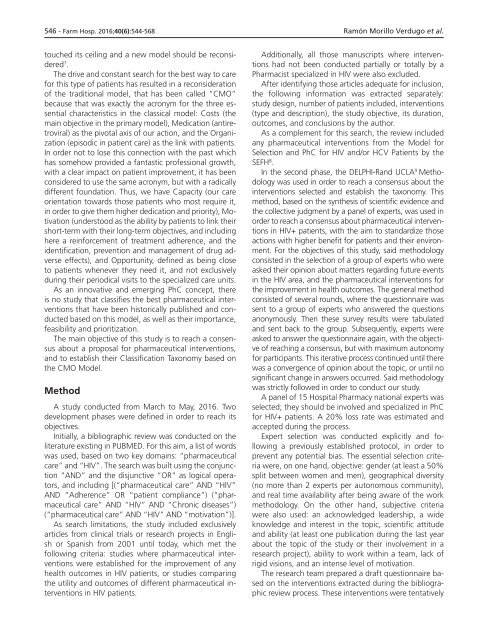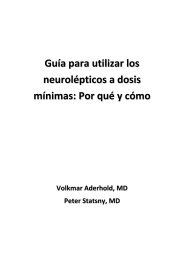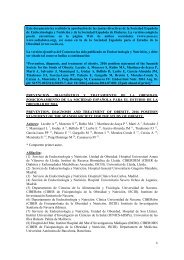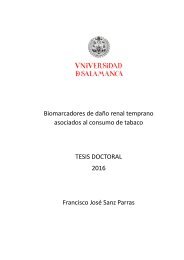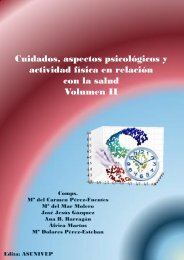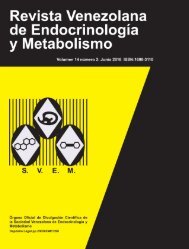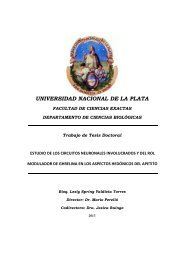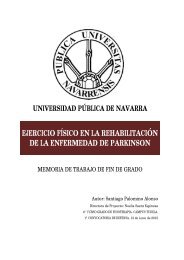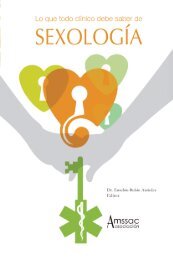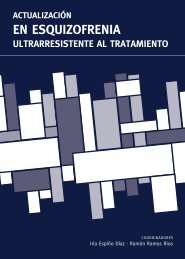Noviembre-Diciembre
156_v40n6(1)
156_v40n6(1)
Create successful ePaper yourself
Turn your PDF publications into a flip-book with our unique Google optimized e-Paper software.
546 - Farm Hosp. 2016;40(6):544-568 Ramón Morillo Verdugo et al.<br />
touched its ceiling and a new model should be reconsidered<br />
7 .<br />
The drive and constant search for the best way to care<br />
for this type of patients has resulted in a reconsideration<br />
of the traditional model, that has been called “CMO”<br />
because that was exactly the acronym for the three essential<br />
characteristics in the classical model: Costs (the<br />
main objective in the primary model), Medication (antiretroviral)<br />
as the pivotal axis of our action, and the Organization<br />
(episodic in patient care) as the link with patients.<br />
In order not to lose this connection with the past which<br />
has somehow provided a fantastic professional growth,<br />
with a clear impact on patient improvement, it has been<br />
considered to use the same acronym, but with a radically<br />
different foundation. Thus, we have Capacity (our care<br />
orientation towards those patients who most require it,<br />
in order to give them higher dedication and priority), Motivation<br />
(understood as the ability by patients to link their<br />
short-term with their long-term objectives, and including<br />
here a reinforcement of treatment adherence, and the<br />
identification, prevention and management of drug adverse<br />
effects), and Opportunity, defined as being close<br />
to patients whenever they need it, and not exclusively<br />
during their periodical visits to the specialized care units.<br />
As an innovative and emerging PhC concept, there<br />
is no study that classifies the best pharmaceutical interventions<br />
that have been historically published and conducted<br />
based on this model, as well as their importance,<br />
feasibility and prioritization.<br />
The main objective of this study is to reach a consensus<br />
about a proposal for pharmaceutical interventions,<br />
and to establish their Classification Taxonomy based on<br />
the CMO Model.<br />
Method<br />
A study conducted from March to May, 2016. Two<br />
development phases were defined in order to reach its<br />
objectives.<br />
Initially, a bibliographic review was conducted on the<br />
literature existing in PUBMED. For this aim, a list of words<br />
was used, based on two key domains: “pharmaceutical<br />
care” and “HIV”. The search was built using the conjunction<br />
“AND” and the disjunctive “OR” as logical operators,<br />
and including [(“pharmaceutical care” AND “HIV”<br />
AND “Adherence” OR “patient compliance”) (“pharmaceutical<br />
care” AND “HIV” AND “Chronic diseases”)<br />
(“pharmaceutical care” AND “HIV” AND “motivation”)].<br />
As search limitations, the study included exclusively<br />
articles from clinical trials or research projects in English<br />
or Spanish from 2001 until today, which met the<br />
following criteria: studies where pharmaceutical interventions<br />
were established for the improvement of any<br />
health outcomes in HIV patients, or studies comparing<br />
the utility and outcomes of different pharmaceutical interventions<br />
in HIV patients.<br />
Additionally, all those manuscripts where interventions<br />
had not been conducted partially or totally by a<br />
Pharmacist specialized in HIV were also excluded.<br />
After identifying those articles adequate for inclusion,<br />
the following information was extracted separately:<br />
study design, number of patients included, interventions<br />
(type and description), the study objective, its duration,<br />
outcomes, and conclusions by the author.<br />
As a complement for this search, the review included<br />
any pharmaceutical interventions from the Model for<br />
Selection and PhC for HIV and/or HCV Patients by the<br />
SEFH 8 .<br />
In the second phase, the DELPHI-Rand UCLA 9 Methodology<br />
was used in order to reach a consensus about the<br />
interventions selected and establish the taxonomy. This<br />
method, based on the synthesis of scientific evidence and<br />
the collective judgment by a panel of experts, was used in<br />
order to reach a consensus about pharmaceutical interventions<br />
in HIV+ patients, with the aim to standardize those<br />
actions with higher benefit for patients and their environment.<br />
For the objectives of this study, said methodology<br />
consisted in the selection of a group of experts who were<br />
asked their opinion about matters regarding future events<br />
in the HIV area, and the pharmaceutical interventions for<br />
the improvement in health outcomes. The general method<br />
consisted of several rounds, where the questionnaire was<br />
sent to a group of experts who answered the questions<br />
anonymously. Then these survey results were tabulated<br />
and sent back to the group. Subsequently, experts were<br />
asked to answer the questionnaire again, with the objective<br />
of reaching a consensus, but with maximum autonomy<br />
for participants. This iterative process continued until there<br />
was a convergence of opinion about the topic, or until no<br />
significant change in answers occurred. Said methodology<br />
was strictly followed in order to conduct our study.<br />
A panel of 15 Hospital Pharmacy national experts was<br />
selected; they should be involved and specialized in PhC<br />
for HIV+ patients. A 20% loss rate was estimated and<br />
accepted during the process.<br />
Expert selection was conducted explicitly and following<br />
a previously established protocol, in order to<br />
prevent any potential bias. The essential selection criteria<br />
were, on one hand, objective: gender (at least a 50%<br />
split between women and men), geographical diversity<br />
(no more than 2 experts per autonomous community),<br />
and real time availability after being aware of the work<br />
methodology. On the other hand, subjective criteria<br />
were also used: an acknowledged leadership, a wide<br />
knowledge and interest in the topic, scientific attitude<br />
and ability (at least one publication during the last year<br />
about the topic of the study or their involvement in a<br />
research project), ability to work within a team, lack of<br />
rigid visions, and an intense level of motivation.<br />
The research team prepared a draft questionnaire based<br />
on the interventions extracted during the bibliographic<br />
review process. These interventions were tentatively


